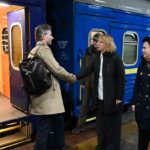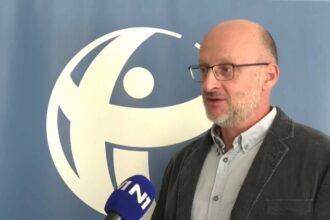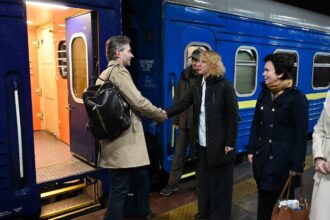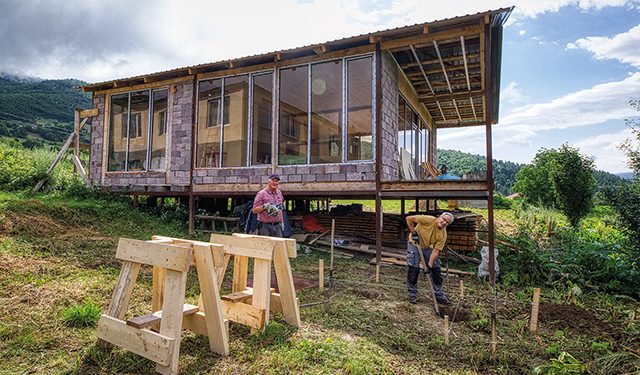The “signatures” that are on our cafe and house come from all over: the work of those who have been involved in building or renovating projects over the years. The house has its first bathroom, built by Canadians with finishing touches done by Mingrelians. It also includes many smaller but essential elements that were done by Americans, Svans from our village, and others.
A pair of Swiss men have just arrived to work. One of them I’ve known for 31 year. Originally they were going to replace the burned-out garage roof. But the previous pair of café workers looked at it and suggested that we strengthen the walls of the garage with cement and rebar, before re-roofing. The Swiss guys will only be here for 10 days and that won’t allow them to finish the garage roofing work. So we have them build a staircase up to the cafe balcony.
In English, the phrase is: Measure twice, cut only once. In Georgian you measure 100 times. This phase of planning and drawing is now underway after some back-and-forth to establish our ideal stair. They will create a list of all the small materials needed (nuts and bolts, screws, etc.)
I can go to Mestia quickly to buy instead going all the way to Zugdidi. They brought power tools from Austria where they live. I picked them up last night from Kutaisi Airport after a direct WizzAir Flight from Vienna. We drove 10 hours in one day, but we were broken up by several hours. We made it home safely through thick fog. I borrowed an angle grinder from a neighbor and we are off.
The gap between the procedural and technical techniques is vast. In Western Europe, it is impossible to build or renovate a structure without going through a long list of bureaucratic and permission requirements. This is done for safety, uniformity and standardization. In Georgian villages you can bypass all of this… and the protection that it brings.
Materials available here range from horribly bad to stunningly high-quality. It sometimes surprises me that the bad things are still around, rather than disappearing, despite the competition. I would choose the more expensive, long-lasting option over the cheaper, which could be dangerous and need to be replaced more often. Electrical fixtures, for instance, are a particular concern. There are many people who can’t afford to buy such high-end items and are forced to buy cheaply and often. So, the inferior quality products continue to be sold. The “luxury of choice” is not a mere marketing slogan.
As we wind down our building and renovations on our Svaneti land, we will not be able to replace the power tools that were in our garage.
Materials (wood and metal), foundation (steel in concreted holes) and finish, as well as joining methods (welding and screws or bolts instead of nails, which will loosen after years of heavy use and cannot be tightened), are all important. One of their first tasks is to make the tools they will need, like a sturdy sawhorse that will become the legs for my next workbench once the men leave. This tool-making is based on the idea that every tool was created by another tool, and so on, until we reach the original proto-tools, such as the first hand hammer. (PLEASE do not plane the sawhorse corners–we do not need it to be so beautiful that its function becomes a pity!)
The drawings and questions alone give us confidence. They are full of knowledge and experience, including some from Africa. We are gaining mutual understanding and feel our exchanges will bear fruit for a long time. Swiss made is synonymous with quality, precision, and longevity. Thank you for adding another set of signatures.
Blog by Tony Hanmer
Tony Hanmer is a writer and photographer who has been working for GT since 2011. He has lived in Georgia and Svaneti, respectively, since 1999. He runs the “Svaneti Renaissance” Facebook group, now with nearly 2000 members, at www.facebook.com/groups/SvanetiRenaissance/
He and his wife also run their own guest house in Etseri: www.facebook.com/hanmer.house.svaneti
Read More @ georgiatoday.ge













